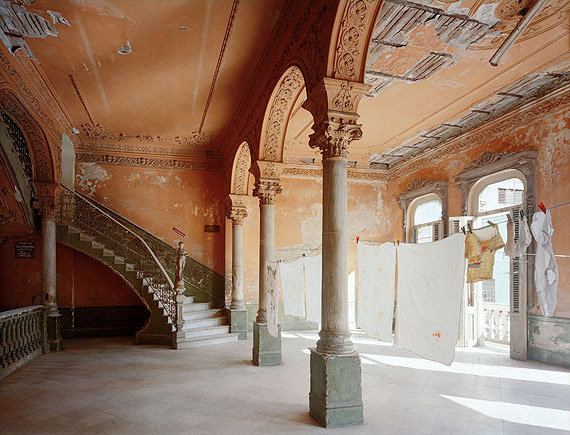Robert Polidori
dal 9/2/2012 al 20/4/2012
Segnalato da
9/2/2012
Robert Polidori
Camera Work Contemporary Gallery, Berlin
A comprehensive exhibition of the photographer. Apart from the most iconic, world-famous images from his oeuvre, several new works will be presented for the first time. Fascinating architectural photographs of the Palace of Versailles, the Kremlin and the Cuban capital Havanna...

On February 10, CAMERA WORK opened the CWC GALLERY, a second gallery in a Berlin building that is steeped in history: the Ehemalige Jüdische Mädchenschule Berlin (former Jewish girls’ school). CWC GALLERY, in keeping with the name CAMERA WORK CONTEMPORARY, will show contemporary positions in photography, painting and sculpture in comprehensive retrospectives, conceptual group exhibitions or cooperations with private collectors and art institutions. CWC GALLERY was inaugurated with a comprehensive exhibition of photographer Robert Polidori’s work that opened on February 10. Apart from the most iconic, world-famous images from his oeuvre, several new works will be presented for the first time.
The comprehensive exhibition will allow for an in-depth look into Robert Polidori’s impressive oeuvre. Fascinating photographs of the Palace of Versailles, the Kremlin and the Cuban capital Havanna will be presented next to selected works from the series "Zones of Exclusion: Pripyat and Chernobyl" and "After the Flood" with photographs from New Orleans after hurricane "Katrina". In addition to these series, the exhibition will feature selected architectural photographs by Robert Polidori from New York, Los Angeles and Berlin.
Feudal splendour and colourful patina – Robert Polidori’s search for vestiges of the past in the Palace of Versailles, the Kremlin and Havanna
The focus of the exhibition is on Polidori’s extensive photographic documentation of the rebuilding and restauration of the Palace of Versailles which he followed for over 25 years. The magnificent rooms, the elaborate renovation work on the palace during the 1980s and the portraits of noblemen and -women in golden frames that constitute Polidori’s subjects give the viewer an idea of the past of this historic place, conserving it meticulously. At the same time, history coalesces with the present and allows for a new aesthetic experience of this lavishly adorned, regally decorated and yet forgotten world. Gold embellishments, polished wood inlays and glittering chandeliers as far as the eye can see characterize Polidori’s photographs of the Kremlin in Moscow, which used to be the home of the of czars and other rulers and is the seat of the Russian government again today. These complex, quiet images complete the circle between yesterday and today. The ravages of time are also evident in Polidori’s photographs from Havanna. They depict crumbling, flaking, cracking structures, while simultaneously fascinating the viewer with their brilliant, rich colours and contrasts.
Traces of history in Robert Polidori’s architectural photography
Polidori’s photographs are distinguished by their graceful silence, their precise aesthetic composition and their colourful complexity and power. Though printed in very large formats, the images do not sacrifice their accuracy of detail, which allows the viewer to almost sense the structure of shapes and surfaces through his eyes: the complex photographs let us experience the pictured spaces in a new way.
The point of contact between old and new is a recurring motive in Polidori’s work. The rooms that he photographs, although completey void of any human presence, tell their manifold stories through their unique patina and their palatial splendour. In 2009, he photographed the "Neues Museum" in Berlin, which was elaborately restored and redesigned by British architect David Chipperfield, adding new features to the old structures while deliberately conserving those parts in which the ravages of time were clearly visible.
Polidori’s testimony to destruction: Nuclear exclusion zones and natural disasters
In his work, Robert Polidori also documents the often devastating effects of human interference with the environment, as he did in his photo series about the nuclear reactor disaster in Chernobyl. He has also portrayed the disastrous damage done to the city of New Orleans by hurricane "Katrina" in 2005. Selected works from both series will be presented in the exhibition. Polidori, portraying not only the palaces of the world, but also scenes of destruction and tragedy, thus uses architectural photography as a means to make the recipient think about the pictured places in a different way. His photographs of the Hotel Ambassador in Los Angeles, one of which will be shown in the exhibition, can be read in a similar way. The hotel won notoriety when it became the scene of the assassination of Robert Kennedy in 1968. It was torn down in 2005.
About Robert Polidori
Robert Polidori was born in Montreal, Canada, in 1951 and lives in New York and Paris. Big photo stories in magazines like The NewYorker – for which Polidori is, like Martin Schoeller, an editorial photographer – Architectural Digest, Geo or Vanity Fair established Polidori’s international success, which has been honored by important awards such as the Deutsche Fotobuchpreis or the Alfred Eisenstaedt Award. Polidori’s work has not only been shown by numerous galleries, but was also featured in several internationally acclaimed museums such as the Metropolitan Museum of Art in New York, the Musée d’Art Contemporain de Montréal and the Martin-Gropius-Bau in Berlin. Polidori’s substantial oeuvre has also been featued in several publications, among others the three-volume photo book "Parcours Muséologique Revisité" with the monumental photographic documentation of the Palace of Versailles, which was awarded the Liliane Bettencourt Prix de la Photographie.
Image: “LA GUARIDA” RESTAURANT ENTRANCE 418 CONCORDIA, VEDADO, HAVANA, 1997
CWC GALLERY
Auguststraße 11–13
10117 Berlin
Hours: Tuesday - Saturday 12am - 8pm



